 Technology peripherals
Technology peripherals
 AI
AI
 Home appliance industry observation: With the support of AI, will whole-house intelligence become the future of smart home appliances?
Home appliance industry observation: With the support of AI, will whole-house intelligence become the future of smart home appliances?
Home appliance industry observation: With the support of AI, will whole-house intelligence become the future of smart home appliances?
If artificial intelligence is compared to the fourth industrial revolution, then large-scale models are like storing food for the fourth industrial revolution. In the application field, it realizes the desire to revisit the idea envisioned by the Dartmouth Conference in the United States in 1956 and kicks off the reshaping of the world.
According to the definition of major manufacturers, AI home appliances are home appliances with interconnection, human-computer interaction and active decision-making capabilities. AI home appliances can be regarded as the highest form of smart home appliances. However, can the AI-powered whole-house smart model currently on the market become the protagonist of the industry in the future? Will a new competition pattern emerge in the home appliance industry? This article will analyze it from three aspects.
Whole House Intelligence Why is the thunder loud but the raindrops light?
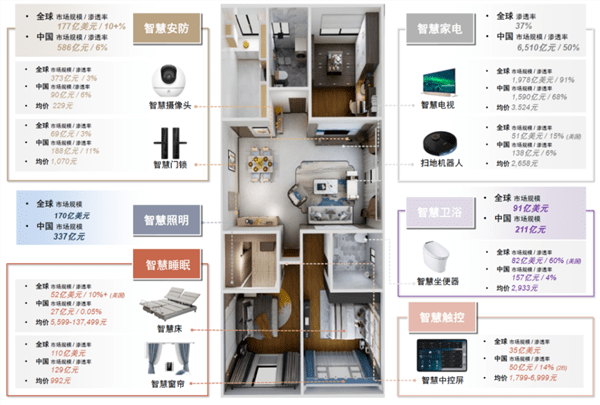
Sources: Statista, Zhongan.com, iResearch, Luotu Technology, National Lock Industry Information Center, China Business Industry Research Institute, Qianzhan Industry Research Institute, Huajing Industry Research Institute, Jiaye Think Tank, CSHIA, Research Jingbi Zhi, Zhiyan Consulting, ISPA, Aowei Cloud Network, China State Grid's "White Paper on the Development of China's Smart Toilet Industry", IDC, Business Research, GFK, Guanyan Tianxia, Grand View Research, Strategy Analytics, Transparency Market Research, CICC, MRFR, KBV Research, IRobot, CICC Research Department
According to Statista data, China’s smart home market will reach US$15 billion in 2020, and is expected to reach US$45.3 billion by 2026, with a compound annual growth rate of over 20%. At the same time, China’s smart home penetration rate is only 13%, and most of the smart home market The penetration rate of household products is less than 10%.
At first glance, my country’s smart home market is huge, but the penetration rate of each category is low. In this case, consumers are more inclined to buy individual home appliances, while whole-house smart solutions are making great noise in the market but making little progress. What is the reason for this to happen?
With the continuous iteration of Internet of Things technology, hardware and software systems and artificial intelligence technology, whole-house intelligence is gradually entering real life from the conceptual level. However, the current whole-house intelligent system still faces some urgent problems that need to be solved, such as passive intelligence, insufficient basic capabilities, the pre-installation mode needs to be combined with decoration, and poor post-installation service experience.
For example, when clothes are stuffed into the drum, more than a dozen washing and care modes are displayed on the washing machine operating screen, and the user has to search online to find which one to choose; the decoration team chosen by the consumer is not professional enough and does not provide the whole house with Smart layout leaves room for development; because the whole-house smart team is a start-up company without a good after-sales service team, consumer experience is poor and the frequency of using smart functions is reduced.
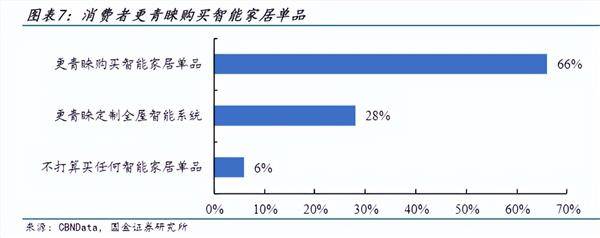
Although there are relatively few choices, in this context, consumers are still more inclined to purchase smart home appliances. The results of the 2021 Consumer Smart Home Consumption Willingness Survey show that 66% of consumers are more willing to buy a single smart home product, while only 28% of consumers are willing to choose a customized smart home system. At present, the main reason why consumers prefer to use smart single products is because there are technical bottlenecks and the design and installation process is cumbersome, which will lead to poor user experience.
Insufficient intelligence and cumbersome installation problems are becoming stumbling blocks to increasing the penetration rate of whole-house intelligence. With the support of AI and the advancement of the integrated market, the booming development of whole-house intelligence is becoming possible.
With the blessing of AI, whole-house intelligence is expected to enter a stage of high-prosperity development
Large models bring new definitions to the interaction between people.
In the past few decades, the interaction method has undergone three changes, and now the command line is the main programming interaction interface. Type a command and it will give the user the response they need. This seemed very effective at the time, but most people didn't know what to do.
The simpler interaction method later - the graphical user interface (GUI) appeared. Use the mouse to click on the menu one by one. Although this change is friendlier than the last time and understandable to most people, it is not the most natural way to interact.
The emergence of artificial intelligence enables humans to communicate with computers in natural language. For example, if a user wants to take a hot bath immediately after get off work, in the past, he may have to adjust the temperature to the appropriate temperature according to the climate conditions, and the light and exhaust of the bathroom heater need to be adjusted by himself, which is very troublesome. As long as the user interacts with the computer using natural language, the computer can immediately execute complex commands, allowing the user to directly enter the bathroom through voice commands.
However, current active intelligence research is still in its infancy. The degree of intelligence of the whole-house intelligent system depends on the maturity and accuracy of the AI algorithm built into the intelligent control system on the one hand, and the richness of the behavioral database of the user's living habits on the other. AI is based on the database. Self-learning and reasoning, ultimately forming intelligent solutions.
Due to the constraints of artificial intelligence technology, the active intelligence of most whole-house intelligent systems on the market is still in its infancy, mainly performing single-point, linear operations. In the future, with the maturity of artificial intelligence algorithms and the enhancement of autonomous learning capabilities, whole-house intelligent systems will be able to proactively sense user needs, thereby autonomously constructing different scenarios and improving the user experience.
When designing whole-house intelligence, factors such as user needs and house structure must be taken into consideration. Sensors, gateways, and equipment locations must be preset during wiring. They must be configured according to different needs and actual conditions. Flexible design can ensure the intelligent operation of the whole house.
In addition, higher-function whole-house intelligence often requires the linkage of multiple devices. For example, in the layout of smart security, a series of devices such as sensors, smart door locks, smart cat eyes, and smart central controls are used together. Play a role. Due to individual needs and complex design requirements, it is often difficult for owners to complete the design alone and usually requires the assistance of professional designers.
In the future, with the continuous upgrading of artificial intelligence, the design side can even realize independent design of artificial intelligence, which can not only ensure the accuracy of the design, but also ensure the rationality of the design while improving the user experience.
The effect of AI blessing whole-house intelligence is equivalent to redefining home. It can even be said that whoever does a good job in AI whole-house intelligence business will be the new king of the home appliance industry in the future.
The three-winged bird was born
Today’s competitors for whole-house intelligence can be divided into two departments: Internet companies that develop AI large models, and traditional home appliance leaders that will apply large models in the future.
In this era of Internet of Everything, the development of whole-house smart homes is considerable. According to predictions from Wanlian Securities, China's smart home market will reach 800 billion yuan by 2030, and the current market size will double. Therefore, this market will become a battleground for major giants.
Powerful smart home companies such as Huawei, Alibaba, and Xiaomi are constantly increasing investment in research and development to provide comprehensive solutions for smart homes and contribute to the development of smart homes.
For example, Huawei’s Whole House Intelligence 4.0 was officially released in May, launching innovative interactive devices such as the industry’s first space-traveling screen “Smart Central Control Screen S2” and a new space interaction partner “Smart MINI”. In addition, the newly upgraded super quick control and smart voice also allow consumers to meet more diverse scene needs through simpler operations.
However, the author believes that Huawei and Xiaomi may have gone astray in their whole-house smart approach. Because the central control screen or mobile phone remote control is a "tasteless" product concept, the future development of whole-house intelligence will definitely be decentralized. All home appliances or smart sensors in the user's home should be non-sensory interactive, rather than through A touch screen "remote control" is implemented.
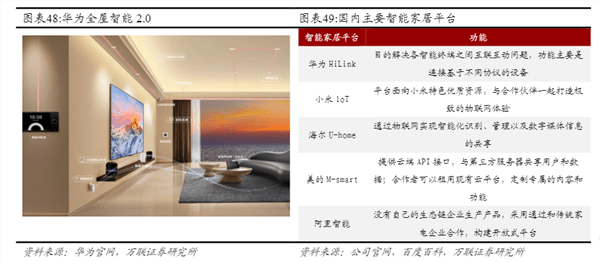
In terms of smart interconnection, Haier Smart Home, which has been deeply involved in home appliances for decades, has found a way.
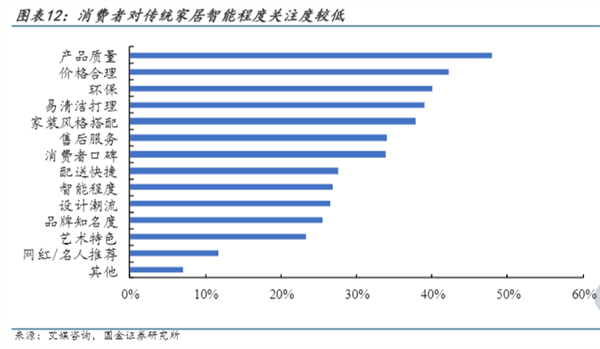
According to iiMedia Consulting statistics, among the factors consumers pay attention to in home consumption in 2021, product quality/reasonable price/environmental protection account for 47.9%/42.2%/40.0% respectively, and only 26.9% pay attention to the demand for intelligence. . The application scenarios of the technological advantages of whole-house smart solution providers in traditional home products still need to be further explored, but Haier, the leading company in the home appliance industry, has already found the best solution.
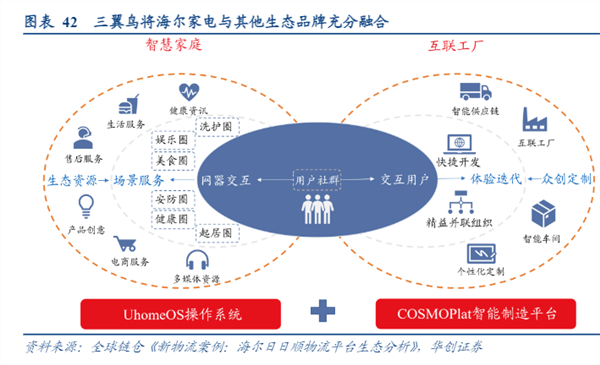
Haier's ecosystem is to connect various ecological brands that have been established before. In essence, it takes the Haier home appliance brand as the core, uses the COSMO Kaos platform as the supply side, uses UhomeOS as the system side, and Casarte serves as the product end, RiRiShun serves as the logistics end, and then adds Youwu Intelligence and other related projects to the home category, ultimately forming the largest piece of the puzzle in the Haier ecosystem - the Three-Winged Bird.
The three-winged bird comes from the Classic of Mountains and Seas. It is one of the ten sacred birds. It has three heads, three wings and six claws. Its name is "Shang Fu".
Three-winged Bird, as a connection platform between Haier ecosystem and end consumers, plays a leading role in expanding industry boundaries, exploring user needs, and integrating multi-party resources.
The Three-winged Bird brand has brand advantages that other Internet companies do not have. Haier's share of major appliances exceeds 30% and is ranked No. 1 all year round. Casarte has an exclusive advantage in high-end refrigerators and freezers. Years of education have strengthened market recognition. The home decoration process is long and complicated, including but not limited to design, material selection, construction, acceptance and other aspects, involving professional knowledge in many different fields. Various details are high threshold and quite cumbersome for consumers. Compared with experiencing it themselves, today's Generation Z is more willing to choose a decoration brand like Sanyiniao endorsed by a listed company. This is a "dimensionality reduction blow" for today's decoration industry with poor information transparency.
Moreover, the brand's channel advantage is also scarce in the market. Triwing Bird has grown rapidly in the "1 2" model based on Haier's offline network, integrating channel enterprises to form an alien alliance. We combine online and physical stores to assist in attracting traffic, with more than 10 million monthly active users, realizing omni-channel home decoration services.
The most critical point is that Sanyiniao has completely abandoned the traditional single-product sales strategy of home appliances, and insisted on the "three no-sales" with the courage to "break the cauldron and sink the boat":
What we sell is not a single product, but a smart life;
What we sell is not a single transaction, but a lifetime service;
What we sell is not a single demand, but personalized customization.
In the "smart home" built by Haier Triwing Bird, the refrigerator can "remember" what ingredients you put in it and prepare food for you based on your needs and the tastes of your family. When you get home at night and walk into the smart bathroom, the water heater has been prepared for your living habits. It provides hot water as soon as it is turned on, and it can also automatically dehumidify after taking a bath. Sitting on the sofa in the living room, you can just say: "I want to "Watch TV", the TV will automatically play back the last program you watched, and you can check the operating status of other household appliances; on the smart balcony, put the clothes in the washing machine and say "Xiaoyou, Xiaoyou, clean up" , the robot will automatically clean the floor.

It is not difficult to achieve this. Sanyiniao’s unique “one-stop smart home” service has already covered everything from design to construction to later home appliances and furniture. At present, it seems that only a few brands such as Sanyiniao can achieve true active whole-house intelligence.
Three-winged Bird's strategy is somewhat similar to BYD's historical reenactment of its initial full-scale entry into the new energy vehicle industry. Haier Smart Home will most likely become the only leader in the AI whole-house intelligence industry. The current competitive landscape of the three giants in the home appliance industry may be Entering into a situation of one super and multiple powers. The three-winged bird is not only the future representative of Haier Smart Home, but also the core of the smart home strategy.
The above is the detailed content of Home appliance industry observation: With the support of AI, will whole-house intelligence become the future of smart home appliances?. For more information, please follow other related articles on the PHP Chinese website!

Hot AI Tools

Undresser.AI Undress
AI-powered app for creating realistic nude photos

AI Clothes Remover
Online AI tool for removing clothes from photos.

Undress AI Tool
Undress images for free

Clothoff.io
AI clothes remover

AI Hentai Generator
Generate AI Hentai for free.

Hot Article

Hot Tools

Notepad++7.3.1
Easy-to-use and free code editor

SublimeText3 Chinese version
Chinese version, very easy to use

Zend Studio 13.0.1
Powerful PHP integrated development environment

Dreamweaver CS6
Visual web development tools

SublimeText3 Mac version
God-level code editing software (SublimeText3)

Hot Topics
 1377
1377
 52
52
 An AI entrepreneurial idea suitable for programmers
Apr 09, 2024 am 09:01 AM
An AI entrepreneurial idea suitable for programmers
Apr 09, 2024 am 09:01 AM
Hello everyone, I am Casson. Many programmer friends want to participate in the development of their own AI products. We can divide the product form into four quadrants based on the "degree of process automation" and "degree of AI application". Among them: the degree of process automation measures "how much of the service process of the product requires manual intervention" and the degree of AI application measures "the proportion of AI application in the product". First, limit the ability of AI to process an AI picture application. The user passes the application within the application. The complete service process can be completed by interacting with the UI, resulting in a high degree of automation. At the same time, "AI image processing" relies heavily on AI capabilities, so AI application is high. The second quadrant is the conventional application development field, such as developing knowledge management applications, time management applications, and high process automation.
 Home appliance industry observation: With the support of AI, will whole-house intelligence become the future of smart home appliances?
Jun 13, 2023 pm 05:48 PM
Home appliance industry observation: With the support of AI, will whole-house intelligence become the future of smart home appliances?
Jun 13, 2023 pm 05:48 PM
If artificial intelligence is compared to the fourth industrial revolution, then large models are the food reserves of the fourth industrial revolution. At the application level, it allows the industry to revisit the vision of the Dartmouth Conference in the United States in 1956 and officially begins the process of reshaping the world. According to the definition of major manufacturers, AI home appliances are home appliances with interconnection, human-computer interaction and active decision-making capabilities. AI home appliances can be regarded as the highest form of smart home appliances. However, can the AI-powered whole-house smart model currently on the market become the protagonist of the industry in the future? Will a new competition pattern emerge in the home appliance industry? This article will analyze it from three aspects. Why does the whole house intelligence sound louder than rain? Source: Statista, Zhongan.com, iResearch Consulting, Luotu Technology, National Lock Industry Information Center
 Generative AI technology provides strong support for manufacturing companies to reduce costs and increase efficiency
Nov 21, 2023 am 09:13 AM
Generative AI technology provides strong support for manufacturing companies to reduce costs and increase efficiency
Nov 21, 2023 am 09:13 AM
In 2023, generative artificial intelligence (Artificial Intelligence Generated Content, AIGC for short) has become the hottest topic in the technology field. There is no doubt that for the manufacturing industry, how should they benefit from the emerging technology of generative AI? What kind of inspiration can the majority of small and medium-sized enterprises that are implementing digital transformation get from this? Recently, Amazon Cloud Technology worked with representatives from the manufacturing industry to discuss the current development trends of China's manufacturing industry, the challenges and opportunities faced by the digital transformation of traditional manufacturing, and the innovative reshaping of manufacturing by generative artificial intelligence. Share and in-depth discussion of the current application status of generative AI in the manufacturing industry. Mention China's manufacturing industry
 IMAX Chinese AI art blockbuster moves theaters to classic landmarks
Jun 10, 2023 pm 01:03 PM
IMAX Chinese AI art blockbuster moves theaters to classic landmarks
Jun 10, 2023 pm 01:03 PM
IMAX China's AI art blockbuster moves theaters to classic landmark Lijiang Time News Recently, IMAX created China's first AI art blockbuster. With the help of AI technology, IMAX theaters "landed" in the Great Wall, Dunhuang, Guilin Lijiang, and Zhangye Danxia. There are many classic domestic landmarks in the area. This AI art blockbuster was created by IMAX in collaboration with digital artists @kefan404 and NEO Digital. It consists of four paintings. IMAX’s iconic super large screen may be spread on Zhangye Danxia’s colorful nature “canvas”, or it may carry thousands of years of history. Dunhuang, a city with rich cultural heritage, stands next to each other, blending into the landscape of Guilin's Li River, or overlooking the majestic Great Wall among the mountains. People can't help but look forward to the day when their imaginations will come true. Since 2008 in Tokyo, Japan
 Huawei Yu Chengdong said: Hongmeng may have powerful artificial intelligence large model capabilities
Aug 04, 2023 pm 04:25 PM
Huawei Yu Chengdong said: Hongmeng may have powerful artificial intelligence large model capabilities
Aug 04, 2023 pm 04:25 PM
Huawei Managing Director Yu Chengdong posted an invitation to the HDC conference on Weibo today, suggesting that Hongmeng may have AI large model capabilities. According to his follow-up Weibo content, the invitation text was generated by the smart voice assistant Xiaoyi. Yu Chengdong said that Hongmeng World will soon bring a smarter and more considerate new experience. According to previously exposed information, Hongmeng 4 is expected to make significant progress in AI capabilities this year, further consolidating AI as the core feature of the Hongmeng system.
 AI technology accelerates iteration: large model strategy from Zhou Hongyi's perspective
Jun 15, 2023 pm 02:25 PM
AI technology accelerates iteration: large model strategy from Zhou Hongyi's perspective
Jun 15, 2023 pm 02:25 PM
Since this year, Zhou Hongyi, the founder of 360 Group, has been inseparable from one topic in all his public speeches, and that is artificial intelligence large models. He once called himself "the evangelist of GPT" and was full of praise for the breakthroughs achieved by ChatGPT, and he was firmly optimistic about the resulting AI technology iterations. As a star entrepreneur who is good at expressing himself, Zhou Hongyi's speeches are often full of witty remarks, so his "sermons" have also created many hot topics and indeed added fuel to the fire of large AI models. But for Zhou Hongyi, being an opinion leader is not enough. The outside world is more concerned about how 360, the company he runs, responds to this new wave of AI. In fact, within 360, Zhou Hongyi has already initiated a change for all employees. In April, he issued an internal letter requesting every employee and every employee of 360
 The advantages of AI customer service substitution are fully demonstrated. It will take time for demand matching and popular application.
Apr 12, 2023 pm 07:34 PM
The advantages of AI customer service substitution are fully demonstrated. It will take time for demand matching and popular application.
Apr 12, 2023 pm 07:34 PM
From the era of manual call centers, it has experienced the application of IVR process design, online customer service systems, etc., and has developed to today's artificial intelligence (AI) customer service. As an important window for serving customers, the customer service industry has always stood at the forefront of the times, constantly using new technologies to develop new productivity, and moving towards high efficiency, high quality, high service, and personalized, all-weather customer service. With the increase in the number of customers and the rapid increase in labor service costs, how to use new generation information technologies such as artificial intelligence and big data to promote the transformation of customer service centers in various industries from labor-intensive to intelligent, refined, and refined? Technology transformation and upgrading has become an important issue facing many industries. Benefiting from the continuous advancement of artificial intelligence technology and the rapid development of scenario-based applications,
 Why is information equality the most important positive significance that AI brings to mankind? Explore the stories of the future
Sep 21, 2023 pm 06:21 PM
Why is information equality the most important positive significance that AI brings to mankind? Explore the stories of the future
Sep 21, 2023 pm 06:21 PM
In a world full of future technologies, artificial intelligence has become an indispensable assistant in human life. However, artificial intelligence is not only to facilitate our lives, it is also changing the structure and operation of human society in a quiet way. One of the most important positive implications is that information equality eliminates the digital divide so that everyone can equally enjoy the convenience brought by technology. In the current digital era, informatization has become an important force in promoting social development. However, we are also facing a real problem, that is, there is a digital divide, which prevents some people from enjoying the convenience brought by technology. Therefore, equal rights in informatization are particularly important. It can eliminate the digital divide, allow everyone to equally share the fruits of scientific and technological development, and achieve overall social progress.



